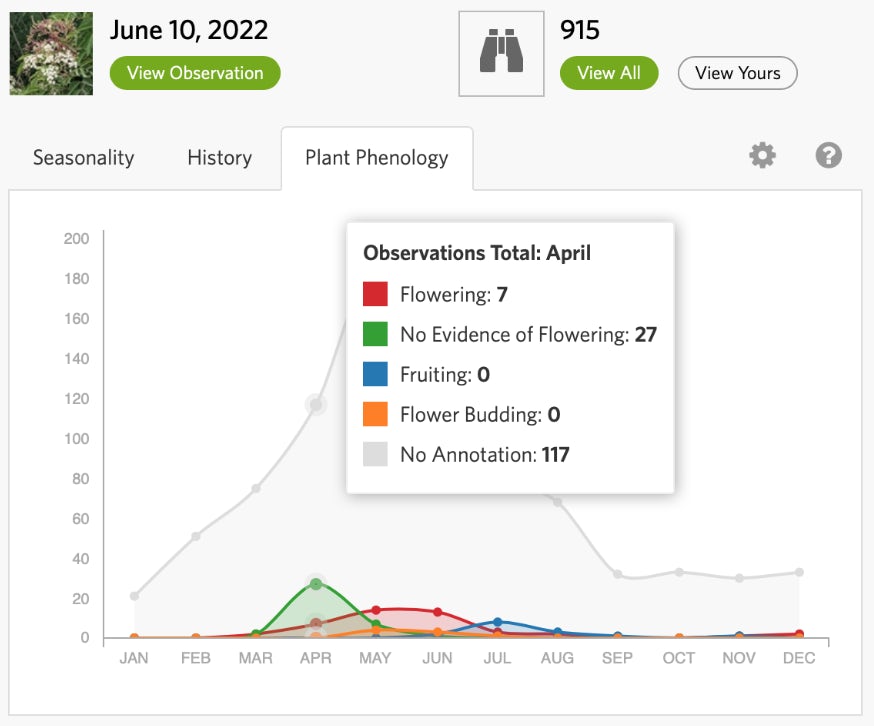Plant Phenology - Black Elderberry
Last June, after seeing the Black Elderberry (Sambucus canadensis) blossoms starting to appear on the plants along just about every major road in the area, I started to wonder when the fruit would be ripest, hoping to harvest some when I eventually found a plant on the property (which didn't happen until this year).
I remembered that iNaturalist had a Plant Phenology attribute, where you can document if the plant is Budding, Flowering, Fruiting, or none of the above, and figured that would be a great way to learn when I might find some nice fruit.
What I found was this:

Out of over 900 observations added to iNat in the state of Louisiana, only a few dozen had been annotated at all. This screenshot might actually be after I started to work on a few! While it gave me some general information on timing, it was disappointing until I realized it was also a great opportunity.
In early 2022 I'd resolved to start using iNaturalist every day as part of doing more naturalist work in general. In the depths of winter, when there wasn't much to observe, I started to look into Identifying on the iNat website, where you can "confirm" other users' observations. This new Elderberry problem offered me the opportunity to help hone my identification skills and add more helpful information to the observations.
So over the last year, in a few different bursts, I have gone through every Black Elderberry observation in the state of Louisiana and added Phenology documentation. Now, the same graph looks like this:

There's a pretty clear picture there now of the progression of the phenology over the course of a year!
Black Elderberry is a good example species as it's still fairly large and noticeable even before it starts flowering, and maintains its woody stems over the winter, so it's often observed even without foliage at all.
Now I'm expanding my efforts to the entire Gulf Coast region — there are 1400+ observations of Sambucus canadensis in the region without a Phenology attribute remaining (the gray line), and I hope to work through those over the rest of the year and continue to flesh out this information for one of my favorite species.







Comentarios
I love what you are doing. It does frustrate me that so few people add notations to their observations. The iNat database would be so much more valuable if we all did this. I began doing it for ALL of my observations over a year ago. It does take a few extra seconds of time but is so worth it. Thanks for posting this.
Thank you Bette! This was actually a great reminder to check my own observations for Phenology, and it turns out I have quite a few where I haven't done it myself! I do wish the iPhone app had a better workflow for adding it while you're uploading a new observation, that tends to be why mine don't get it initially.
So that will be my next project! Thanks again.
You've inspired me to add phenology to my observations.
Well done Bro Daniel and a bit of inspiration to me to do the same... phenologically speaking.
A very cool project. I try to do this with the taxa I'm focusing on too.
A tool that I found greatly improves my speed on these tasks is AutoHotkey. I find for shortcut keys that are far apart on the keyboard, this makes it so much easier. Make a script that has a combo for each annotation and you can do one handed annotating. Thanks for all the work!
@ncb1221 Funny coincidence, I was just looking at your Yaupon/Robin observation and was wondering how you remembered all the various fields that you add to your observations -- good to know! Thank you for the kind words and the recommendation!
I actually do all those manually! I only use the script for when I'm doing bulk annotating. I really like to track interactions between organisms, so those observation fields are some of the ones I use most frequently.
And your annotation of my Yaupon Holly is is how I ended up here in the first place!
Agregar un comentario